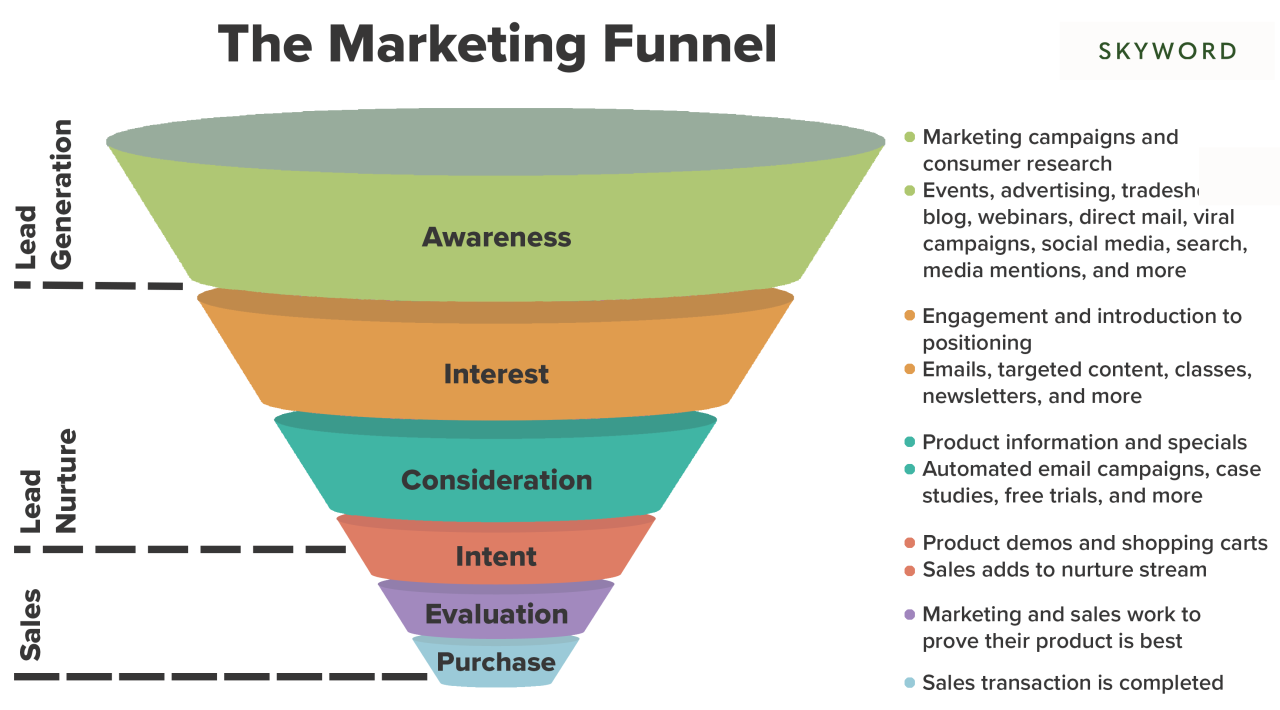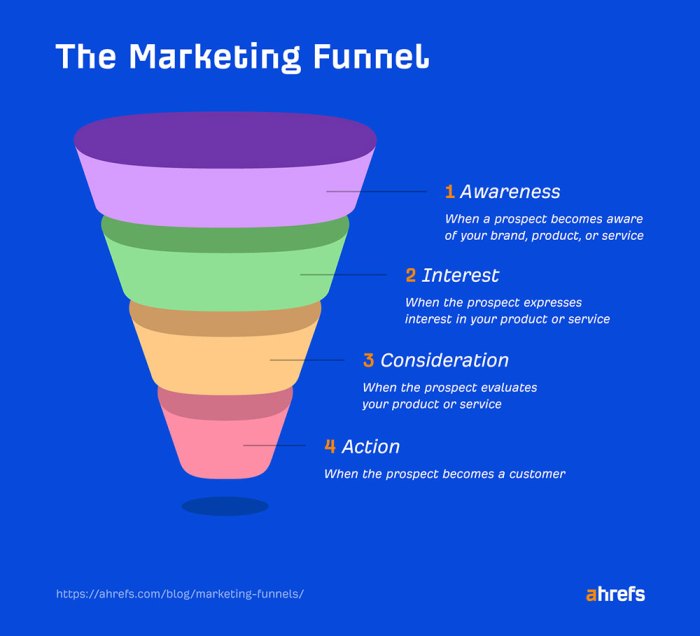Understanding Marketing Funnels sets the stage for this enthralling narrative, offering readers a glimpse into a story that is rich in detail with american high school hip style and brimming with originality from the outset.
Marketing funnels are the secret sauce that can take your business from zero to hero in no time. Buckle up and get ready to dive into the world of strategic marketing tactics that will revolutionize the way you approach your target audience.
Introduction to Marketing Funnels: Understanding Marketing Funnels
A marketing funnel is a strategic framework used by businesses to attract, engage, and convert potential customers into paying customers. It Artikels the customer journey from awareness to purchase, helping businesses to streamline their marketing efforts and optimize their sales process.
Stages of a Typical Marketing Funnel
- The Awareness Stage: This is where potential customers become aware of a product or service through marketing efforts like ads, content, or social media.
- The Interest Stage: Once aware, customers show interest in the product or service, engaging with more information to learn about its benefits.
- The Decision Stage: At this point, customers are ready to make a purchase decision, comparing options and evaluating the best fit for their needs.
- The Action Stage: Finally, customers take action by making a purchase, completing the conversion process in the marketing funnel.
Examples of Marketing Funnels in Different Industries
Marketing funnels are used in various industries to drive sales and build customer relationships. For example, in the e-commerce sector, businesses use funnels to guide customers from product discovery to checkout. Similarly, in the software industry, companies use funnels to convert free trial users into paid subscribers.
Importance of Understanding and Optimizing Marketing Funnels
- Maximizing Conversions: By understanding the stages of the marketing funnel, businesses can identify bottlenecks and optimize each step to increase conversion rates.
- Enhancing Customer Experience: A well-structured marketing funnel ensures a seamless customer journey, leading to improved satisfaction and loyalty.
- Measuring Effectiveness: Monitoring the performance of a marketing funnel provides valuable insights into the effectiveness of marketing campaigns, allowing for data-driven decision-making.
Top of the Funnel (TOFU)
The top of the funnel (TOFU) stage in a marketing funnel is where potential customers first become aware of a brand or product. It is the initial stage of the buyer’s journey, where the focus is on generating leads and building brand awareness.
Purpose of TOFU Stage
At the TOFU stage, the main goal is to attract and capture the attention of a wide audience. This is done through various marketing tactics that aim to create brand awareness and engage with potential customers. By reaching out to a larger audience, businesses can generate leads and move them further down the funnel.
- Content Marketing: Creating valuable and informative content such as blog posts, videos, and infographics can help attract potential customers to your brand.
- Social Media: Utilizing social media platforms to share content, engage with followers, and run targeted ads can help increase brand visibility and attract leads.
- : Optimizing your website and content for search engines can help improve your online visibility and attract organic traffic.
TOFU Strategies for B2B and B2C Businesses
- B2B Businesses: TOFU strategies for B2B businesses often focus on thought leadership, whitepapers, webinars, and industry events to attract leads. Building trust and providing valuable information is crucial in the B2B space.
- B2C Businesses: B2C businesses may use social media influencers, user-generated content, contests, and giveaways to attract leads at the TOFU stage. Creating a strong brand presence and appealing to emotions can be effective in engaging with consumers.
Middle of the Funnel (MOFU)

In the middle of the funnel stage, leads have already shown interest in your product or service and are now being nurtured to move closer to making a purchase. This stage is crucial in converting leads into customers by providing them with valuable information and building trust.
Lead nurturing techniques commonly used in the MOFU stage include personalized email campaigns, targeted content offers, and retargeting ads. By tailoring the messaging to address the specific needs and pain points of leads, marketers can effectively guide them towards making a purchase decision.
Examples of MOFU Content
- Case Studies: Showcase how your product or service has helped previous customers solve their challenges.
- Webinars: Host educational webinars to provide in-depth knowledge about your industry or offerings.
- Product Demos: Offer live demonstrations to give leads a hands-on experience of your product in action.
Importance of Personalized Marketing
Personalized marketing at the MOFU stage is essential in nurturing leads and guiding them through the sales funnel. By tailoring content and communications based on the lead’s behavior, preferences, and interactions with your brand, you can create a more engaging and relevant experience. This personalized approach helps build trust, strengthen relationships, and ultimately drive conversions.
Bottom of the Funnel (BOFU)

The Bottom of the Funnel (BOFU) is a critical stage in the marketing funnel where leads are on the brink of converting into paying customers. This stage focuses on closing sales and retaining customers through targeted strategies and personalized approaches.
Significance of BOFU Stage, Understanding Marketing Funnels
At the BOFU stage, leads have already interacted with your brand, shown interest in your products or services, and are now considering making a purchase. It is essential to provide them with the right incentives and information to push them towards conversion. This stage is crucial for maximizing your ROI and turning potential customers into loyal advocates for your brand.
- Personalized Communication: Tailoring your messaging and offers to meet the specific needs and preferences of each lead can significantly increase conversion rates at the BOFU stage.
- Clear Call-to-Actions: Providing clear and compelling calls-to-action can guide leads towards making a purchase decision, reducing friction in the buying process.
- Retargeting Strategies: Implementing retargeting ads and emails can help re-engage leads who have shown interest but haven’t converted yet, increasing the chances of closing sales.
Conversion Optimization Strategies for BOFU
To optimize conversions at the BOFU stage, it is essential to focus on creating a seamless and personalized experience for leads. By understanding their needs and addressing their concerns effectively, you can increase the likelihood of converting them into customers.
- Offer Free Trials: Providing free trials or demos of your products/services can give leads a firsthand experience of what you offer, building trust and confidence in your brand.
- Provide Discounts or Exclusive Deals: Offering discounts or exclusive deals to leads at the BOFU stage can incentivize them to make a purchase sooner, accelerating the conversion process.
- Showcase Testimonials and Reviews: Sharing testimonials and reviews from satisfied customers can help build credibility and trust, reassuring leads about the quality and value of your offerings.
Customer Retention and Upselling at BOFU
Once a lead has converted into a customer, the focus shifts to retaining them and encouraging repeat purchases. Upselling tactics can also be employed to increase the lifetime value of each customer and drive additional revenue.
- Implement Loyalty Programs: Rewarding loyal customers with exclusive perks and discounts can encourage repeat purchases and foster long-term relationships with your brand.
- Personalized Recommendations: Providing personalized product recommendations based on past purchases and preferences can enhance the customer experience and drive upsells.
- Ongoing Support and Communication: Maintaining regular communication with customers, offering support when needed, and seeking feedback can help strengthen customer relationships and increase retention rates.
